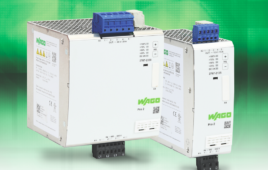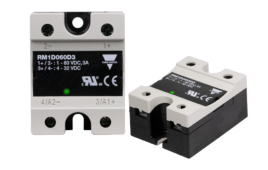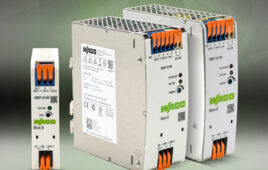Georgia Tech researchers have discovered a way to capture and harness energy transmitted by such sources as radio and television transmitters, cell phone networks, and satellite communications systems. By scavenging this ambient energy from the air around us, the technique could provide a new way to power networks of wireless sensors, microprocessors and communications chips.
“There is a large amount of electromagnetic energy all around us, but nobody has been able to tap into it,” said Manos Tentzeris, a professor in the Georgia Tech School of Electrical and Computer Engineering who is leading the research. “We are using an ultra-wideband antenna that lets us exploit a variety of signals in different frequency ranges, giving us greatly increased power-gathering capability.”

Georgia Tech graduate student Rushi Vyas (front) holds a prototype energy-scavenging device, while School of Electrical and Computer Engineering professor Manos Tentzeris displays a miniaturized flexible antenna that was inkjet-printed on paper and could be used for broadband energy scavenging.
Tentzeris and his team use inkjet printers to combine sensors, antennas and energy-scavenging capabilities on paper or flexible polymers. The resulting self-powered wireless sensors could be used for chemical, biological, heat and stress sensing for defense and industry, radio-frequency identification (RFID) tagging for manufacturing and shipping, and monitoring tasks in many fields including communications and power usage.
Communications devices transmit energy in many different frequency ranges. The team’s scavenging devices can capture this energy, convert it from ac to dc, and then store it in capacitors and batteries. The scavenging technology can presently take advantage of frequencies from FM radio to radar, a range spanning 100 MHz to 15 GHz or higher.
Scavenging experiments using TV bands have already yielded power amounting to hundreds of microwatts, and multi-band systems are expected to generate one milliwatt or more. That amount of power is enough to operate many small electronic devices, including a variety of sensors and microprocessors.

Professor Tentzeris holds a sensor (left) and an ultra-broadband spiral antenna for wearable energy-scavenging applications. Both were printed on paper using inkjet technology.
And by combining energy-scavenging technology with super-capacitors and cycled operation, the Georgia Tech team expects to power devices requiring more than 50 milliwatts. In this approach, energy builds up in a battery-like supercapacitor and is used when the required power level is reached.
The researchers have already successfully operated a temperature sensor using electromagnetic energy captured from a television station that was half a kilometer distant. They are preparing another demonstration in which a microprocessor-based microcontroller would be activated simply by holding it in the air.
Exploiting a range of electromagnetic bands increases the dependability of energy-scavenging devices, explained Tentzeris. If one frequency range fades temporarily due to usage variations, the system can still exploit other frequencies.
The scavenging device could be used by itself or in tandem with other generating technologies. For example, scavenged energy could assist a solar element to charge a battery during the day. At night, when solar cells don’t provide power, scavenged energy would continue to increase the battery charge or would prevent discharging.
Using ambient electromagnetic energy could also provide a form of system backup. If a battery or a solar-collector/battery package failed completely, scavenged energy could allow the system to transmit a wireless distress signal while also potentially maintaining critical functions.
The inkjet technology for printing these energy scavenging devices is a technique they are already using to produce sensors and antennas. The researchers use a standard materials inkjet printer. However, they add what Tentzeris calls “a unique in-house recipe” containing silver nanoparticles and other nanoparticles in an emulsion. This approach lets the team print not only RF components and circuits, but also novel sensing devices based on such nanomaterials as carbon nanotubes.

Professor Tentzeris displays an inkjet-printed rectifying antenna used to convert microwave energy to dc power. This grid was printed on flexible Kapton material and is expected to operate with frequencies as high as 10 GHz when complete.
The researchers believe that self powered, wireless paper-based sensors will soon be widely available at very low cost. The resulting proliferation of autonomous, inexpensive sensors could be used for applications that include:
*Airport security: Airports have both multiple security concerns and vast amounts of available ambient energy from radar and communications sources. These dual factors make them a natural environment for large numbers of wireless sensors capable of detecting potential threats such as explosives or smuggled nuclear material.
*Energy savings: Self-powered wireless sensing devices placed throughout a home could provide continuous monitoring of temperature and humidity conditions, leading to highly significant savings on heating and air conditioning costs. And unlike many of today’s sensing devices, environmentally friendly paper-based sensors would degrade quickly in landfills.
*Structural integrity: Paper or polymer-based sensors could be placed throughout various types of structures to monitor stress. Self-powered sensors on buildings, bridges or aircraft could quietly watch for problems, perhaps for many years, and then transmit a signal when they detected an unusual condition.
*Food and perishable material storage and quality monitoring: Inexpensive sensors on foods could scan for chemicals that indicate spoilage and send out an early warning if they encountered problems.
*Wearable bio-monitoring devices: This emerging wireless technology could become widely used for autonomous observation of patient medical issues.
Georgia Institute of Technology
www.gatech.edu
::Design World::
Filed Under: Wireless • 5G and more, Energy management + harvesting, SENSORS, ELECTRONICS • ELECTRICAL





Tell Us What You Think!